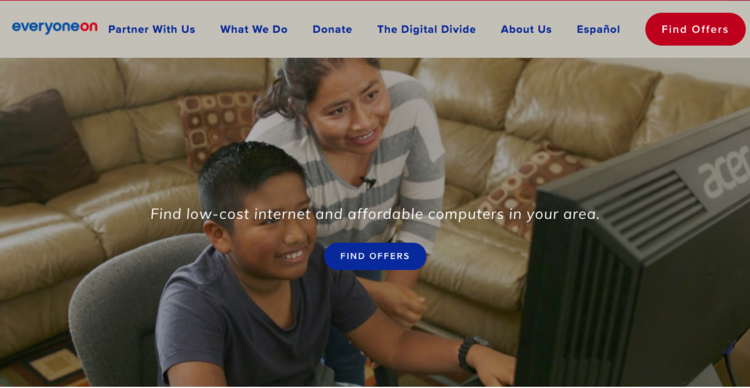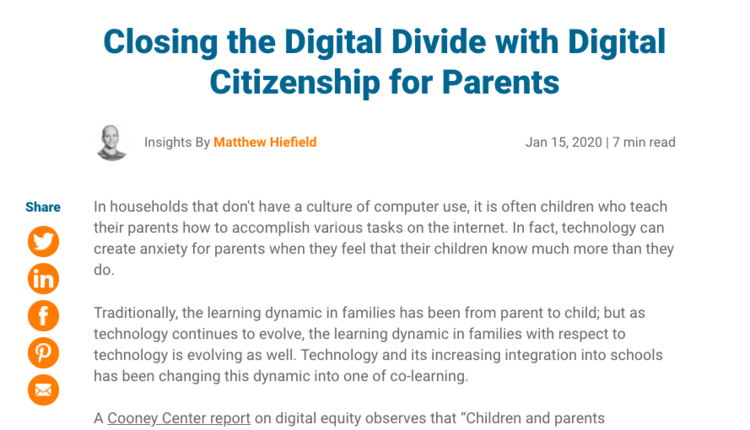This post originally appeared on our ParentSquare Learning Network blog on March 20, 2020.
Curated by Amy Keith at ParentSquare
When having a conversation about technology in education, it’s crucial to consider who has access to the Internet and computers, as well as any factors that prevent or enable families to have these technologies. By recognizing how Internet access varies from family to family, educators can better understand how to meet the needs of all their students.
As schools transition to online learning due to COVID-19, it becomes especially important for educators to be adaptable to families’ varying circumstances and to develop solutions and resources to help families of all circumstances.
Below, you can view some of the highlights from our March 18th Twitter Chat moderated by Brandon Burns (@CoachBurnz). Participants joined in with the hashtag #PSquareLN. Click here to view the whole chat!
Q1: What Is Digital Equity?
“[Digital equity] isn’t just making sure students have access to devices, it also means equipping them with the tools & knowledge to use them safely, effectively & meaningfully!” — Tim Needles, @timneedles
“It begins with ensuring all populations of students have adequate access to digital resources for learning. Focusing especially on student populations who often are overlooked in our system & society. Educating our Ss & Ps for success in the digital realm” — Melody McAllister, @mjmcalliwrites
“Digital equity means supplying Ss with learning opportunities that can be digital but must also have an equivalent no tech alternative. Not every S has internet access or data, so we’ll make sure they can complete work with/without it.” — Laura Steinbrink, @SteinbrinkLaura
“Digital equity makes sure all students, no matter what they have or do not have, will each be given access to technology, platforms, and tools to ensure they can complete their work to their fullest capabilities.” — Ted Huff, Ed.D., @TedHiff

Q2: How Can You Help Ensure Digital Equity?
“I think it’s [about] recognizing that most of the things for most of the people are inequitable, including schools, housing, internet access, tech access, home support, safety, etc. Starting there, one can begin to understand the kinds of steps needed to ensure equity” — Michael J. Crawford, PhD, @mjcraw
“Knowing what Ss have, knowing which Ss have the greatest need, and then working with companies to help meet those needs. There are hot spots that can be purchased, mobile hotspots throughout the community, etc. Assistive technologies are key for some Ss!” — Laura Steinbrink, @SteinbrinkLaura
“See A2 hotpots are great resources for those in need. (http://1millionproject.org) (https://t-mobile.com/business/resources/school-district-t-mobile-partnership…). Remote meetings are also a great way to engage parents. Cell phones are not used to their full potential.” — Coach Burns, @CoachBurnz
“Check out https://everyoneon.org @Everyone_On for ways to support students and parents” — Rachelle Dene Poth, @Rdene915

“I think you can learn up on what equity is, why it’s as rare as it is, what factors are at play, etc., & turn to people who have been & are doing the work. For example: @MichelleSadrena @Tolerance_org @kmishmael @kmjlbrown @ValeriaBrownEdu @laura_mcbain” — Michael J. Crawford, PhD, @mjcraw

Q3: How Can We Partner With Parents To Close the Digital Equity Gap?
“I love parent nights at school, but I’ve always tried to be flexible for individual needs too. Parent communication platforms like @ParentSquare helps me stay up with my parents who work odd hours & can’t make it to school functions” — Melody McAllister, @mjmcalliwrites
“Parent PD helps all parents better understand the need and the ‘why’ behind digital equity. Then our parent support teams/organizations can use their resources to help bridge this gap in the school!!” — Ted Huff, Ed.D., @TedHiff
“Communication is key to partnering with Ps to help the digital equity dilemma. We EDUs need to understand that it is okay if Ps do not want their S to have internet access. When Ps understand the Why & that you respect their position, then real solutions emerge.” — Laura Steinbrink, @SteinbrinkLaura
“You can host parent PD in conjunction with school-wide events (Open House, Conferences).” — Ted Huff, Ed.D., @TedHiff
“Speak with parents and find what they need. Can we offer hot spots, modified assignments, can we let them know of media companies offering free internet service and help with the processes of getting set up. How do we make sure we’re available to listen?” — J Hamilton, @mrmakemathsense
“Help Ps to know how to use and monitor their child’s learning. Help them to understand the benefits of online (our future is there). Also understand if Ps are not comfortable with technology (there is a lot of scary things out there).” — Amy Moran, @amoran4
“Send home resources, directives, instructions and where to find tech support in ANY possible native languages. Your students may speak English; their parents might not…and our students are not a translation service.” — Caitlin O’Connor, @JustTeachingELA
^^ “So true. It is great that so many tools now have #immersivereader and we can use this for our students and families, learned about it while using @Buncee 🙂 tremendous opportunities for using this for language learning and promoting accessibility” — Rachelle Dene Poth, @Rdene915

Q4: With the Current Impact of the Coronavirus on Schools, How Can We Best Promote Digital Equity?
“The #coronavirus crisis is also an opportunity to ensure digital #equity for all students, educators can utilize resources & collaborate to make sure learning is meaningful & every student has access as we transition to online learning as a country!” — Tim Needles, @timneedles
“Share resources! Ask for help when needed. Think about how you can use the cell phone as a better resource. This virus is going to drastically change distance EDU as well as highlighting the difference in access/needs between suburban, rural, & urban families.” — Coach Burns, @CoachBurnz
“1:1 initiatives are great, but those devices don’t work without wifi—which students may not have @ home. Link them to the current companies offering free internet so they can do their assignments or at the very least email to lyk they’re ok” — Caitlin O’Connor, @JustTeachingELA
“Locally, we can ensure anything requiring tech coming from the schools also comes with the tech needed, be it hardware, wifi hotspot, etc. More broadly, if there wasn’t enough energy to act/advocate for digital equity before, there best be the energy to do so now” — Michael J. Crawford, PhD, @mjcraw
Thanks so much to all who contributed to this important conversation about digital equity!

